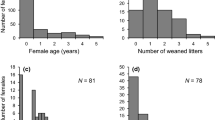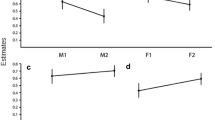Abstract
The timing of reproduction affected litter size, offspring mass, and offspring survival in the Uinta ground squirrel, Spermophilus armatus, in Grand Teton National Park, Wyoming. Survival of juvenile females to yearling age varied negatively with date of weaning and positively with individual offspring mass. At the same time, juveniles weaned early in the season were lighter, and juveniles weaned later in the season were heavier. The coefficient of variation for juvenile body mass, originally measured at weaning, significantly decreased by the time juveniles entered hibernation, indicating that individuals weaned early and light “caught up” in body mass to individuals weaned later and heavier. From the perspective of the mother's investment in the litter, litter size (corrected for mother's mass) decreased with later wcaning dates, while the relationship of weaning date to litter mass (corrected for mother's mass) was significant in only one year. Maternal allocation of resources in litters changed over the season so that mothers produced many, small offspring early in the season, and fewer, large offspring late in the season.
Similar content being viewed by others
References
Anderson PK (1989) Dispersal in rodents: a resident fitness hypothesis (Special publication no. 9). American Society of Mammalogists, Washington
Armitage KB (1981) Sociality as a life-history tactic of ground squirrels. Oecologia 48:36–49
Armitage KB, Downhower JF, Svendsen GE (1976) Seasonal changes in weights of marmots. Am Midl Nat 96:36–51
Charnov EL, Krebs JR (1974) On clutch size and fitness. Ibis 116: 217–219
Dobson FS (1982) Competition for mates and predominant male dispersal in mammals. Anim Behav 30:1183–1192
Dobson FS, Myers P (1989) The seasonal decline in the litter size of meadow voles. J Mammal, 70:142–152
Dobson FS, Badry MJ, Geddes C (1992) Seasonal activity and body mass of Columbian ground squirrels. Can J Zool 70: 1364–1368
Fleming TH, Rauscher RJ (1978) On the evolution of litter size in Peromyscus maniculatus. Evolution 32:45–55
Foltz DW, Hoogland JL, Koscielny GM (1988) Effects of sex, litter size, and heterozygosity on juvenile weight in black-tailed prairie dogs (Cynomys ludovicianus). J Mammal 69:611–614
Holekamp KE (1982) Dispersal in ground-dwelling sciurids. In: Murie JO, Michener GR (eds) The biology of ground-dwelling squirrels. The University of Nebraska Press, Lincoln, pp 295–320
Hosmer DW, Lemeshow S (1989) Applied logistic regression. Wiley, New York
Kaufman DW, Kaufman GA (1987) Reproduction by Peromyscus polionotus: number, size and survival of offspring. J Mammal 68:275–280
Klomp H (1970) The determination of clutch size in birds: a review. Ardea 58:1–124
Lack DL (1947) The significance of clutch size. Ibis 89:302–352
Lack DL (1948) Natural selection and family size in the starling. Evolution 2:95–110
Lack DL (1954) The natural regulation of animal numbers. Clarendon Press, Oxford
Lewontin RC (1966) On the measurementof relative variability. Syst Zool 15:141–142
Michener DR (1974) Annual cycle of activity and weight changes in Richardson's ground squirrel, Spermophilus richardsonii. Can Field Nat 88:409–413
Michener GR (1984) Age, sex, and species differences in the annual cycles of ground-dwelling sciurids: implications for sociality. In: Murie JO, Michener GR (eds) The biology of ground-dwelling squirrels. The University of Nebraska Press, Lincoln, pp 81–107
Michener GR (1989) Reproductive effort during gestation and lactation by Richardson's ground squirrelsOecologia 78:77–86
Michener GR, Locklear L (1990) Over-winter weight loss by Richardson's ground squirrels in relation to sexual differences in mating effort. J Mammal 71:489–499
Murie JO, Boag DA (1984) The relationship of body weight to overwinter survival in Columbian ground squirrels. J Mammal 65:688–690
Murie JO, Dobson FS (1987) The costs of reproduction in female Columbian ground squirrels. Oecologia 73:1–6
Myers P, Master LL (1983) Reproduction by Peromyscus maniculatus: size and compromise. J Mammal 64:1–18
Rieger JF (1991) Female investment strategies and reproductive success in the Uinta ground squirrel, Spermophilus armatus Ph. D. Dissertation, University of Michigan
Sauer JR, Slade NA (1986) Size-dependent population dynamics of Microtus ochrogaster. Am Nat 127:902–908
Sauer JR, Slade NA (1987) Uinta ground squirrel demography: is body mass a better categorical variable than age? Ecology 68: 642–650
Slade NA, Balph DF (1974) Population ecologyof Uinta ground squirrels. Ecology 55:989–1003
Smith CC, Fretwell SD (1974) The optimal balance between size and number of offspring. Am Nat 108:499–506
Sokal RR, Rohlf FJ (1981) Biometry: the principles and practice of statistics in biological research. Freeman, San Francisco
Author information
Authors and Affiliations
Rights and permissions
About this article
Cite this article
Rieger, J.F. Body size, litter size, timing of reproduction, and juvenile survival in the Unita ground squirrel, Spermophilus armatus . Oecologia 107, 463–468 (1996). https://doi.org/10.1007/BF00333936
Received:
Accepted:
Issue Date:
DOI: https://doi.org/10.1007/BF00333936




